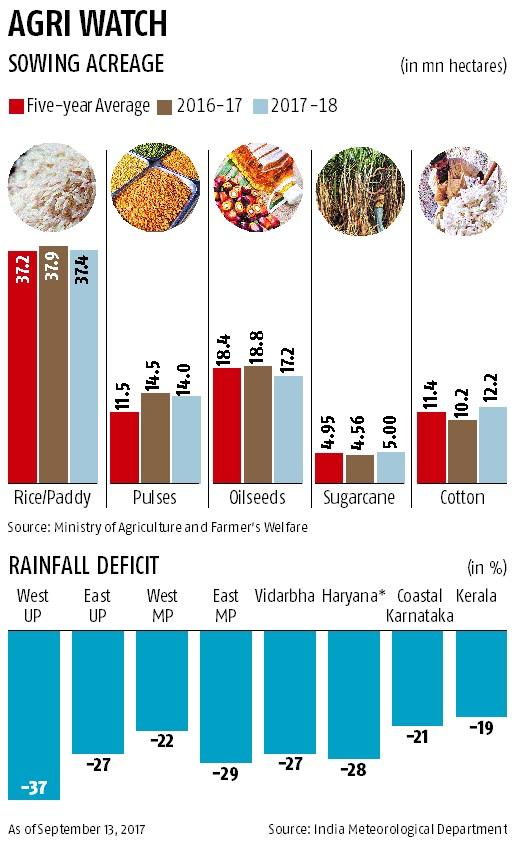Sowing of the kharif (summer) crop has moderated to 104.9 million hectares compared to 105.7 million hectares during the previous year at the same time (mid-September), latest figures from the agriculture ministry reveal. This is still better than the five-year average of 102.4 million hectares. Agricultural yield is “expected to be same as of last year”, the government said in an official statement on Thursday.
Reduced sowing comes in the backdrop of a six per cent monsoon deficit (compared to the long-period average) till mid-September. Major agricultural regions Uttar Pradesh (31 per cent), Madhya Pradesh (25 per cent) and Vidarbha (27 per cent) in Maharashtra have had the biggest deficits.
But meteorological deficit hurts different regions unevenly.
Despite a severe deficit — Amethi, Kushinagar, Hamirpur, Jalaun, Mahamayanagar and Agra districts in UP are facing a 60 per cent-plus deficit — state agriculture officials are positive. “The situation in UP is not as bad as meteorological data suggests. More than 80 per cent irrigation coverage and a good groundwater table empowers farmers with a safety net in a deficient monsoon.
"Paddy, which constitutes half the cropped area in UP, is already at 70 per cent maturity, and we also hope for good rains in the last week of September, evident from forecasts,” a senior official at the state agriculture directorate, who did not wish to be named, said.
On the other hand, a 27 per cent deficit in largely unirrigated and drought-prone Vidarbha might affect agriculture in a worse manner. Maharashtra — a leader in cotton production — has sown cotton on a record area in 2017, at 4.2 million hectares, and Vidarbha plants 40 per cent of the cotton in Maharashtra.
Short-duration crops in Vidarbha — especially urad and moong — will suffer damage to some extent, but the long-duration cotton crop derives hope from a positive rainfall forecast in the coming weeks, an agriculture department official, who did not wish to be named, said.
Cotton farmers in India, too, would be keen to deploy additional resources to improve cotton yield, when the early reports of international cotton importers turning to India after the hurricane aftermath in the US — the biggest cotton exporter — reach them.
Dispersion of rainfall a bigger concern
“Accumulated rainfall deficit is no doubt a concern, but the intervals between wet and dry spells — temporal variations in rainfall — are better input indicators with regard to crop yields,” the UP official said.
The week-by-week variation in rainfall, published by the Met department, shows that in the high-deficient regions mentioned above, most weeks in June registered above-average rainfall, partially owing to pre-monsoon thunderstorm activity.
For a majority of the districts in UP, MP and Vidarbha in Maharashtra, the rainfall anomalies — the departure from normal rainfall — from the second week of August — have been negative. Agriculture officials from these regions are hopeful on two counts: One, most districts and crops in UP and MP have gained sufficient maturity from June and July rains; and two, end-of-September forecast for central and northern India is positive.
Vidarbha, on the other hand, has seen wider dry spells, with only two weeks — one in mid-July and other at the end of August — registering more-than-normal rains.


